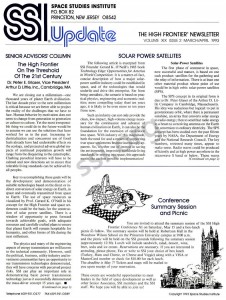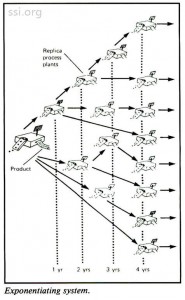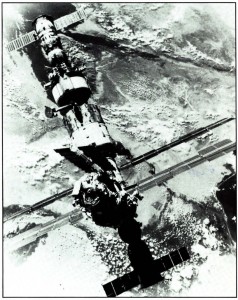SPACE STUDIES INSTITUTE
P.O. BOX 82
PRINCETON, NEW JERSEY 08542
[[librarian note: This address is here, as it was in the original printed newsletter, for historical reasons. It is no longer the physical address of SSI. For contributions, please see this page]]
SSI UPDATE
THE HIGH FRONTIER® NEWSLETTER
VOLUME XIX ISSUE 2 MARCH/APRIL 1993
SENIOR ADVISORS’ COLUMN
The High Frontier On The Threshold
Of The 21st Century
Dr. Peter E. Glaser
Vice President
Arthur D. Little, Inc., Cambridge, MA
We are closing out a millennium – one thousand years of planet Earth civilization. The last decade prior to the next millennium is critical because we are better able to project the reality of the challenges that we have to face. Human behavior by motivation does not seem to change from generation to generation or culture to culture. Yet the most irresponsible thing we could do in the future would be to assume we can use the solutions that have worked for us in the past. Increasing industrialization and concurrent use of fossil fuels already have had undesirable effects on the ecology, and projected adverse global impacts of continued population growth will range from the disquieting to the catastrophic. Clashing parochial interests will have to be calmed and new directions set to ensure that tolerable living standards can be achieved by all peoples.
Key to accomplishing these goals will be the development and demonstration of suitable technologies based on the direct or indirect conversion of solar energy on Earth, in space and eventually transmitted from space to Earth. The use of space resources as visualized by Prof. Gerard K. O’Neill in his concept for the High Frontier and space settlements could be the basis for the construction of solar power satellites. There is a window of opportunity to press forward towards achievable goals, with adequate resources and carefully crafted plans to ensure that planet Earth will remain hospitable for humanity, and other forms of life during the next millenium.
The physics and many of the engineering aspects of energy transmission are well known to the technical community. However, until the political, business, utility industry and investment communities have an opportunity to see transmission technologies demonstrated, they will have concerns with perceived project risks. SSI can play an important role in demonstrating basic power transmission technology just as it successfully demonstrated the mass-driver concept 15 years ago.
SOLAR POWER SATELLITES
The following article is excerpted from SSI Founder Gerard K. O’Neill’s 1983 book Technology Edge: Opportunities for America in World Competition. It is a matter-of-fact, concise description of how a major solar power satellite industry could be established in space, and of the technologies that would underlie and drive this enterprise. Far from being unrealistic, the scenario is based on practical physics, engineering and economic realities; more compelling today than ten years ago, it is likely to be even more so ten years from now.
Such an industry can not only provide the clean, low-impact, high-volume energy necessary for the continuance and advance of human civilization on Earth, it can also be the foundation for the extension of civilization into space. With industry of this magnitude, both the need for and a means of supporting true space settlements become increasingly apparent. So, whether out of interest in saving the environment, improving worldwide living standards, or moving into space, this approach merits the earliest possible implementation!
Solar-Power Satellites
The first phase of commerce in space, now successful and mature, is based on one such product: satellites for the gathering and the relay of information. There is at least one other material product whose point of use would be in high orbit: solar-power satellites (SPS).
The SPS concept in its original form is due to Dr. Peter Glaser of the Arthur D. Little Company in Cambridge, Massachusetts. His idea was audacious but logical: to put in geostationary orbit, where there is permanent sunshine, an array that converts solar energy to radio energy; then to send that radio energy in a beam to a receiving antenna on the Earth for conversion to ordinary electricity. The SPS concept has been studied over the past fifteen years by NASA, the Department of Energy and the National Research Council. The key numbers, reviewed many times, appear to make sense. Radio waves could be produced efficiently and at high power anywhere in the microwave S band or below. Those waves could be directed to a receiving antenna in the form of a flat array several miles in extent, held on poles above fields and meadows.
Sunlight and rain would penetrate the array, but the microwaves would not, so land below the antenna could be farmed or grazed. The microwaves could be converted to electricity with an efficiency of more than 90 percent – far higher than the efficiency of a coal or nuclear power plant. Environmental effects have been studied with particular care, and the SPS appears to be quite benign, with no measurable effect even on insects and birds that fly through the densest part of the radio beam.
The potential market for power satellites could be very great indeed, if SPS plants could be sold at a cost competitive with that of coal or nuclear plants. A typical SPS would supply 10,000 megawatts (10 gigawatts, abbreviated GW) to the power lines on Earth. Its salable value delivered to geostationary orbit would be at least $10 billion, because it could supply that power without using any fuel. The installed electric-generator capacity worldwide as of 1980 was about 10,000 GW, and the average life of a generating plant was about thirty years. Replacement alone with SPS plants would therefore open a market with a potential of about $300 billion per year worldwide. Growth at 3 percent per year would create another $300 billion annual market. Penetration of those markets even to the 10 percent level over the next decades would open a new industry with annual revenues of $60 billion; substantial penetration could open an industry comparable to the worldwide automobile industry.
The problem with that rosy picture is transport costs. It would take fairly exotic engineering, with correspondingly high costs, to reduce the weight of a 10GW SPS to 100,000 tons. For it to sell competitively with coal and nuclear, the price of the power station in geostationary orbit would have to be well under $50 per pound. But transport costs from the Earth, at Shuttle rates, would be at least 60 times as great. (Lifting SPS components from low orbit to geostationary would roughly double their transport cost from the Earth.) To reduce the transport costs to 30 percent of the final sale price would require bringing those costs down to a two-hundredth of the present level. An independent committee of the National Research Council, set up to review the SPS concept, refused to believe the transport costs could be brought that low.
It seems that the problem of transport costs could be overcome by a radically different approach which builds on two of the growth markets we have already covered: microengineering and robotics. It also builds on a fact known since the time of Newton: that the energy required to lift an object from the Moon to a high orbit is less than a twentieth as much as to lift it from the Earth. We could build satellite power stations out of lunar materials, and take advantage of the Moon’s low gravity and vacuum environment to transport those materials to orbit at low cost. We could accelerate materials at the lunar surface to a speed so great that they would escape the Moon entirely.
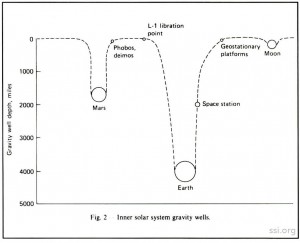
The most efficient machine for that purpose is called a “mass driver,” and it is a form of linear synchronous electric motor, based on the same physics that was used in designing the Transrapid-06. The mass driver would be shaped as a pipe, 16 inches in diameter and 800 feet long. The pipe would consist of a stack of aluminum coils. Within the hollow pipe another coil, the “bucket,” would move. It would be supported and guided by magnetic fields, and would hold in a cavity at its center a baseballsized payload of sintered lunar soil. The bucket would be accelerated through the pipe by magnetic forces produced by currents discharged successively into the outer “drive” coils. Those currents would be taken from a solar-cell array nearby.
Computer-aided design has led to a plan for the mass driver. It specifies a total weight of 10 tons for the complete installation, including the solar-cell array. The first two thirds of the machine would provide the acceleration for the loaded bucket, to a speed of 1.5 miles per second. The last one third would decelerate the empty bucket to a stop. The acceleration cycle would be repeated every five seconds, and with operation during the 35 percent of the time that the Sun is high in the lunar sky, the mass driver would transport annually some 800 tons of lunar material – 80 times its own weight – to a point high above the Moon. The payloads would climb out of the Moon’s gravity, losing speed each second, until finally after sixty hours they arrived at the collection point.
——————————————
Remarkably, every study so far carried out shows
that it could become profitable within a decade.
——————————————
One other novel device is required if lunar materials are to be used for construction: a chemical processing plant to separate the lunar soils into pure elements. Thanks to the Apollo project, we know well what those elements are. The lunar surface consists of minerals very similar to clays found on Earth, but without their water content. By weight, it is about 30 percent metals, 20 percent silicon and 40 percent oxygen. Studies of the processing plant indicate that it could separate about 100 times its own weight in lunar soil each year. The technologies for the mass driver and the chemical-separation plant for lunar soil are now being developed through funding from a unique institution, the Space Studies Institute (SSI).
SSI, based in Princeton, New Jersey, is unique in that it supports developmental research entirely through contributions from individual citizens. It takes no government money and receives only a small fraction of its support from industry. SSI’s mass-driver research is carried out through a grant by SSI to Princeton University. Three successful working models of mass driver have been built.
The latest, with a cross section and design acceleration equal to those of a final lunar machine, agrees closely in performance with the computer program by which it was designed. Research aimed toward a processing plant for lunar soils is being done through an SSI grant to Rockwell International, at the same Downey, California, facility where many Shuttle designers work. In the first two years of that research, completed in 1983, Rockwell specialists under the direction of Dr. Robert Waldron measured all the chemical reactions necessary for the separation that were not already well known from previous industrial chemistry.
Experts in several fields assembled in workshops sponsored by SSI to find the most cost-effective way in which a space industry could be established, based on the mass driver and on the chemical separation of lunar soils. The participants operated on the rule “Invent as little as possible.” They took the Space Shuttle in its present form as the only Earthto-orbit transport system that would be available. They assumed a vehicle for transport between orbits of the kind that is in fact already being developed out of the Centaur launch vehicle. They went back to the Apollo Lunar Module to see how a reusable lunar lander could be derived from the Centaur. They took a given the technologies for life support and communications that have already been tested in space. And they took from industrial experience the observation that it saves development costs to parallel identical machines for each increase in production volume rather than to scale up to a larger machine.
In the SSI plan that emerged from the workshops, there would be just three units to develop that had no close counterparts in today’s space hardware: the mass driver, the chemical-processing plant and a “job shop,” a general-purpose complex of machines able to shape and weld metal. Each of the three units would be small enough and light enough to constitute a single Shuttle payload. The first two would be designed for automatic, unattended operation. The job shop, while highly automated, would be monitored and controlled through radio and television from the Earth.
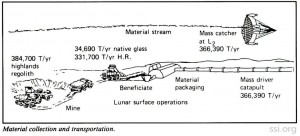
Once the three units were fully checked out, both on the Earth and later in low-Earth orbit, they would be emplaced on the Moon, and copies of the processing plant and job shop would be put into a high orbit between the Earth and the Moon. Then, controlled from the Earth, they would go to work. The processor and shop on the Moon would turn out the simplest, heaviest, most repetitive components of a second mass driver: the drive coils and solar-cell arrays.
The principal by-product of the lunar processor would be oxygen, which would be liquefied and used as propellant for the lander. (The lander’s Centaur engine would burn a mixture that was 15 percent hydrogen and 85 percent oxygen by weight.)
The processor and job shop in orbit would also turn out the simplest, heaviest components of a second processor and job shop. An additional Shuttle flight would deliver to low-Earth orbit the light, complex, laborintensive components needed to complete a second, identical set of units on the Moon and in space: computers, communications electronics, automated controllers, precision machine components. Finally the second set of units would be complete, and with it the production capacity would be doubled.
About eight doublings, estimated to take less than three years in all, would be enough, without any development of new hardware, to reach a production throughput of a quarter million tons per year. That capacity, turned to the fabrication of SPS plants, could turn out one per year, with a salable value of about $10 billion per year. As the materials for those SPS plants would come almost entirely from the Moon at low cost, the plants would be simple, rugged – and correspondingly heavy. Their primary energy conversion would probably use either amorphous silicon cells or turbogenerators.
A new kind of SPS must be designed, under the ground rules that its weight does not matter, but that almost everything in it must be fabricable from lunar materials. With the completion of SSI’s plan, any company, nation or consortium that has sufficient technical expertise will be able to implement it. Implementation is estimated to take five to seven years, including the three years of capacity doublings that will construct the mature space industry. Both that time and the estimated investment required are comparable to those of the Alaskan Pipeline, a wholly private venture.
Opening a substantial industry in space, based on materials from the Moon and on the constant, reliable solar energy found in high orbit, is by far the most speculative commercial opportunity of those we have examined. But it is also the biggest opportunity of all. It could free Earth’s industries from their terrestrial limits and also solve one of humanity’s greatest problems: how to supply clean energy for long-term worldwide economic growth. Remarkably, every study so far carried out show that it could become profitable within a decade.
Manufacturing in space carries such implications for national as well as commercial rivalry that we cannot yet tell what nation or company will be the first to mine the Moon and build power satellites; but within six months after it begins, there will be others imitating it.
FOR YOUR LIBRARY:
SOLAR POWER SATELLITE BOOKS
The Technology Edge: Opportunities for America in World Competition by Gerard O’Neill, 1983. This book is available in softcover, trade paperback format through Space Studies Insitute for $9.95, postage paid.
Solar Power Satellites, the emerging energy option by Peter Glaser, 1993. This newly published book is available through Prentice Hall, Professional Technical Reference Division, Des Moines, IA for $64.75. For more information, please contact Prentice Hall at xxx-xxx-xxxx.
MIR SYMPOSIUM TO TAKE PLACE
July 27-28, 1993
NPO Energia, the Russian organization that runs the MIR space station, has announced a historic two-day symposium that will focus on the capabilities of the MIR space station. The event will take place on July 27-28 in the Washington, DC, region. It marks the first time that the Russian space organization that controls the MIR has assembled the key engineers for the MIR space station together in this type of public forum.
The announcement for the meeting takes place against the backdrop of an increasing willingness on the part of U.S. space officials to incorporate either Russian hardware or expertise as part of the international space station, Freedom.
Recent press accounts have quoted NASA Administrator Dan Goldin, as being seriously interested in assuring that the U.S. and Russian space stations are compatible in terms of orbits, resupply and even docking. Others, however, are calling for a joint MIRFREEDOM station.
Whatever the final decision, this symposium will be a cost-efficient means to meet with the world-class engineers of NPO Energia, and to learn firsthand the challenges of conducting space research, remote sensin, communications, EVA’s, repair work and overall design and development on a manned orbiting platform.
The symposium is being coordinated by our office, Energia USA, which is the American subsidiary of NPO Energia.
Government rates for the two-day event are $495; industry rates are $575; this includes all meals.
We are hopeful that this symposium will mark the beginning of an era of greater commercial cooperation between the American and Russian space programs.
For further information, please call Energia USA at xxx-xxx-xxxx.
Energia USA’s management includes two SSI Senior Advisors: Mr. Jeffrey Manber and Mr. Christopher Faranetta.
Conference Summary Session and Picnic
You are invited to attend the summary session of the SSI High Frontier Conference XI on Saturday, May 15 and a box-lunch picnic to follow. The summary session will be held at Robertson Hall in the Woodrow Wilson School on the Princeton University campus at 9:00 a.m. and the picnic will be held on the SSI grounds following the summary session (approximately 12:30). Lunch will include sandwich, salad, dessert, wine, beer, soda and ice cream. Reservations are necessary. If you are interested in attending, please phone, Fax or write to SSI your choice of box lunch (Turkey, Ham and Cheese, or Cheese and Veggie) along with a VISA or MasterCard number or check for $10.00 for each lunch. The deadline is May 7! Tickets and maps will be mailed to you upon receipt of your reservation.
These events are wonderful opportunities to meet leaders in the field of space development as well as other Senior Associates, SSI members and the SSI staff. We hope you will be able to join us!
PHOTO AND ILLUSTRATION CREDITS
The illustrations on pages two and four of this newsletter are reprinted from Dr. Glaser’s book, Solar Power Satellites, the emerging energy option, with the permission of the author, the publisher, Ellis Horwood Limited, and Prentice Hall.
The photograph of the MIR space station on page three was given to us by Energia USA. It has never before been published.
ABOUT THE INSTITUTE
The Space Studies Institute is a nonprofit, international, research and educational organization. Founded in 1977, it is dedicated to opening the high frontier of space.
SSI’s goals include using the material wealth and solar energy of space to improve the human condition both for those who live on Earth and those who live in space, and building Earth-like habitats in space to expand the ecological range of humanity throughout the solar system and ultimately, perhaps, throughout the galaxy.
To this end, SSI has conducted and is conducting pioneering research into advanced space propulsion, the extraction and processing of nonterrestrial materials for engineering purposes, and the identification and location of lunar and asteroidal resources.
SSI is a board member of the International Space University. The Senior Associates and Members of SSI provide the critical financial support that makes possible its continuing research and educational programs.
To inquire about the Senior Associates and Member programs, please call xxx-xxx-xxxx.
©space studies institute

